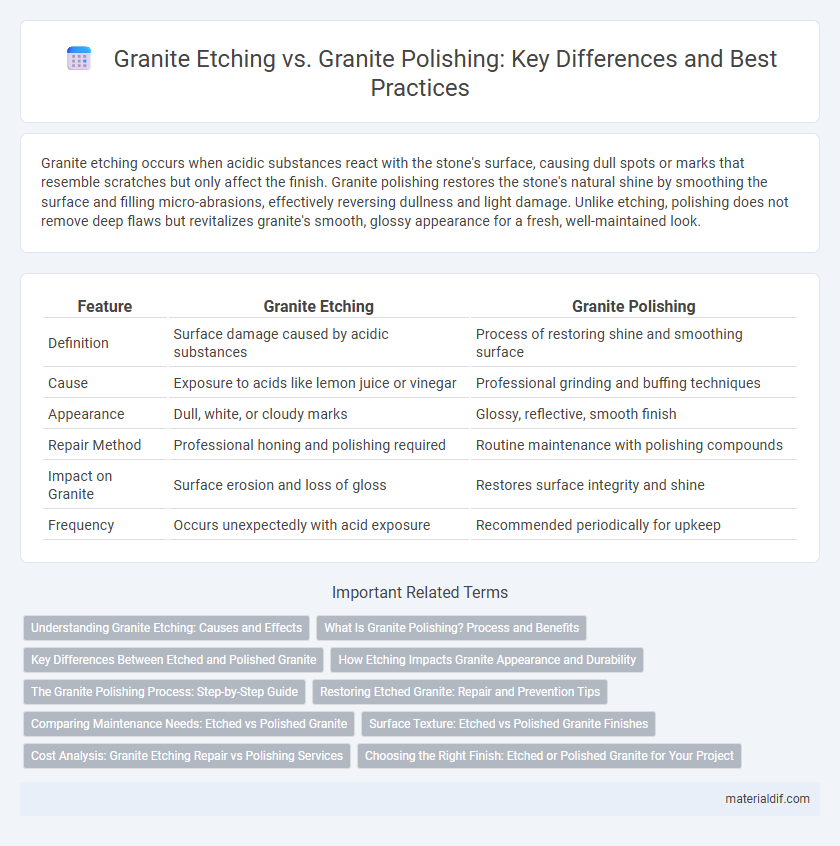Granite etching occurs when acidic substances react with the stone's surface, causing dull spots or marks that resemble scratches but only affect the finish. Granite polishing restores the stone's natural shine by smoothing the surface and filling micro-abrasions, effectively reversing dullness and light damage. Unlike etching, polishing does not remove deep flaws but revitalizes granite's smooth, glossy appearance for a fresh, well-maintained look.
Table of Comparison
| Feature | Granite Etching | Granite Polishing |
|---|---|---|
| Definition | Surface damage caused by acidic substances | Process of restoring shine and smoothing surface |
| Cause | Exposure to acids like lemon juice or vinegar | Professional grinding and buffing techniques |
| Appearance | Dull, white, or cloudy marks | Glossy, reflective, smooth finish |
| Repair Method | Professional honing and polishing required | Routine maintenance with polishing compounds |
| Impact on Granite | Surface erosion and loss of gloss | Restores surface integrity and shine |
| Frequency | Occurs unexpectedly with acid exposure | Recommended periodically for upkeep |
Understanding Granite Etching: Causes and Effects
Granite etching occurs when acidic substances like lemon juice or vinegar react with the stone's surface, leading to dull spots or discoloration that compromise its natural luster. This damage happens because the acid chemically breaks down the resin or sealant, exposing the granite to further wear and staining. Unlike polishing, which restores shine by mechanically buffing the surface, etching requires targeted repair to remove the etched areas and preserve the granite's durability and aesthetic appeal.
What Is Granite Polishing? Process and Benefits
Granite polishing is a restoration process that enhances the stone's natural shine by grinding and buffing the surface with progressively finer abrasive pads. This method removes minor scratches and etching caused by acidic substances, restoring the granite's smooth, reflective finish. Benefits of granite polishing include improved appearance, increased resistance to staining, and prolonged countertop lifespan.
Key Differences Between Etched and Polished Granite
Etched granite displays a dulled, matte surface caused by acid or abrasive exposure that removes the polished layer, often used for decorative effects or etching patterns. Polished granite exhibits a glossy, reflective finish achieved through grinding and buffing that enhances color depth and surface smoothness, ideal for countertops and luxury applications. The key differences lie in texture, appearance, and maintenance, with polished granite being more resistant to staining and easier to clean compared to the porous, etched surface.
How Etching Impacts Granite Appearance and Durability
Granite etching occurs when acidic substances react with the stone's surface, causing dull spots and loss of shine, which diminishes its visual appeal and smooth finish. Unlike polishing, which restores the stone's glossy sheen by smoothing microscopic surface imperfections, etching damages the protective layer, making granite more vulnerable to stains and erosion. Regular professional polishing not only revives the granite's natural luster but also reinforces its durability by sealing the surface against further etching effects.
The Granite Polishing Process: Step-by-Step Guide
Granite polishing involves a step-by-step process starting with grinding the surface using coarse diamond pads to remove scratches and imperfections. Next, progressively finer grits smooth the granite, enhancing its natural sheen and restoring its glossy finish. Final polishing with a high-speed buffer and polishing powder seals the surface, improving durability and resistance to stains.
Restoring Etched Granite: Repair and Prevention Tips
Granite etching occurs when acidic substances damage the stone's surface, creating dull spots or discoloration, while granite polishing restores its natural luster and smoothness by removing these imperfections. To repair etched granite, use a granite polishing powder or a professional honing process that resurfaces the stone without compromising its integrity. Prevent future etching by promptly cleaning spills with a pH-neutral cleaner and applying a high-quality stone sealer to protect the granite's surface from acidic damage.
Comparing Maintenance Needs: Etched vs Polished Granite
Etched granite requires more frequent maintenance as the surface is more porous and prone to staining and dullness compared to polished granite. Polished granite features a smooth, sealed surface that resists stains and scratches, reducing the need for regular upkeep. Proper sealing extends the lifespan of both finishes, but etched granite demands more careful cleaning and periodic resealing to maintain its appearance.
Surface Texture: Etched vs Polished Granite Finishes
Etched granite features a rough, matte surface achieved through acid or abrasive treatments that create a textured, natural look ideal for slip resistance. Polished granite undergoes a grinding and buffing process to produce a smooth, glossy finish that enhances color depth and reflects light for an elegant appearance. The surface texture directly influences durability and maintenance, with etched granite resisting scratches better, while polished granite requires regular sealing to preserve its shine.
Cost Analysis: Granite Etching Repair vs Polishing Services
Granite etching repair typically costs less than comprehensive granite polishing services, with etching treatments averaging between $50 and $150 per incident, while full polishing can range from $200 to $700 depending on the slab size and severity of wear. Etching repair addresses surface-level acid damage or dull spots quickly and economically, whereas polishing restores the granite's entire surface, enhancing shine and smoothness but requiring more labor and materials. Evaluating the long-term benefits versus upfront costs is crucial, as frequent light etching repairs might cumulatively exceed the expense of periodic professional polishing that extends the stone's lifespan.
Choosing the Right Finish: Etched or Polished Granite for Your Project
Granite etching creates a textured, matte surface by using acidic solutions to selectively wear away the stone, enhancing slip resistance and adding a natural, rustic appearance ideal for outdoor applications. Polished granite features a smooth, glossy finish achieved through grinding and buffing, which intensifies the stone's color and pattern, making it a popular choice for countertops and interior decorative elements. Selecting the right finish depends on the project's aesthetic goals and functional needs, with etched granite offering durability and slip safety, while polished granite provides a sleek, high-end look.
Granite etching vs Granite polishing Infographic

 materialdif.com
materialdif.com